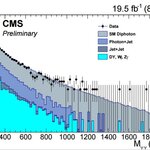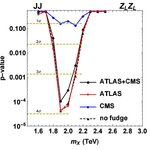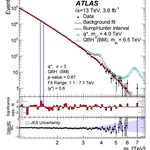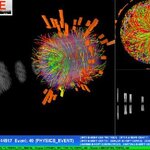Physics

Jim Olsen is giving the CMS talk on 13 TeV results. CMS recorded 90% of the 4 inverse femtobarns delivered by the LHC, but only 2.8/fb were taken with the magnet at 3.8 Tesla (for the rest of the time the magnet was off due to a problem with the helium purity).A plot of the dimuon invariant mass of 60,000,000 events collected by dimuon triggers was shown, which is a pleasure to watch. I will attach it here later.
CMS has 18 new searches for beyond-the-standard model effects. For objects with masses above 1 TeV the sensitivity of 2.2/fb of analyzed data may be larger than the sensitivity of…

As most of you already know, today at 3PM two back-to-back talks by Jim Olsen (CMS) and Marumi Kado (ATLAS) at CERN will disclose the latest results of physics analyses performed on 13 TeV proton-proton collisions recorded this year by the two experiments. (To follow the talks see here).
Among the rumours that circulated before the event, one is persistent: it speaks of an excess of events with two photons, at an invariant mass of 750 GeV or so.
As ground-breaking as 13 TeV are, one must remember that only 4 inverse femtobarns of collisions have been collected this year, as opposed…

Normal
0
MicrosoftInternetExplorer4
The Standard Model is crying for new basic flavor-geometric
physics
Numerous experimental confirmations of the
SM predictions may indicate that besides the problem of many free parameters
the SM is a complete low energy theory of elementary particle interactions not
crying for new physics. But there are serious problems. Wonderful almost
universal empirical particle flavor mass and mixing hierarchies are strange in
the SM, and there are basic flavor related coincidences that beg…

Tomorrow at 2PM two back-to-back talks by Jim Olsen and Marumi Kado at CERN will disclose the newest results of the CMS and ATLAS experiments, which will be based on the analysis of 2.5 to 4 inverse femtobarns of 13 TeV proton-proton collisions acquired by the experiments this year.Why should you be interested ? Of course, because the year could end with a boom! Maybe the experiments have found evidence for something totally unexpected in their data. After all, 13 TeV is 63% more energy than 8 TeV.
Mind you - if you thought that a particle X of, say, 9 TeV could be spotted in this year'…

When we look out at the universe – even with the most powerful of telescopes – we can only see a fraction of the matter we know must be there. In fact, for every gram’s worth of atoms in the universe, there is at least five times more invisible material called “dark matter”. So far scientists have failed to detect it, despite spending decades searching.
The reason we know it exists is because of the gravitational pull of galaxy clusters and other phenomena we observe. The matter we can see in a cluster isn’t enough to hold it together by gravity alone, meaning some additional invisible or…

In this blog, I challenge the vaulted role that tensor calculus enjoys today. I will define a concrete example of what I consider to be a technical flaw in the tools of tensor calculus in all modern physics theories. The complaint is about completeness, that partial stories are not good enough. Please feel free to defend the status quo in the comments.
The relativistic quantum field equation for a spin 0 particle is the Klein-Gordon equation (written in natural units):
One takes the first derivative of the wave function. Also take three spatial derivatives. Then take the second time…

As I am sure happens with many other human occupations, the job of a particle physicist proceeds in bursts of activity interspersed with periods of more relative calm. Deadlines must be met, and sometimes several of them overlap. The life of a physicist can get miserable for short periods of time, but after those end one usually looks back with satisfaction at the accomplishments.
For me this is such a period. I must deliver the draft of my book, "Anomaly!", to the publisher by the end of January, and in the meantime I must take care of many other important tasks: the organization of three…

This week's graph is a reminder that particle physicists are, deep in their bones, bump hunters. Sure, some of my colleagues could best be described as detector builders; others as software wizards; still others as statistical gurus. But what excites us the most is to go hunting for a bump in a mass histogram. That's because spikes in mass histograms have been the way to produce particle discoveries ever since particle physics became a discipline, some eighty years ago. What is more exciting than findind a new resonance, which maybe forces a complete overhaul of our understanding of…

The Large Hadron Collider (LHC) has been colliding protons at record high energy since the summer, but now the time has now come to collide large nuclei (nuclei of lead, Pb, consist of 208 neutrons and protons).
Why? In the very beginning, just a few billionths of a second after the Big Bang, the Universe was made up of an extremely hot and dense 'primordial soup' consisting of the fundamental particles, especially quarks and gluons. This state is called the quark-gluon-plasma (QGP). Approximately one millionth of a second after the Big Bang, quarks and gluons became confined inside the…

Have you recently obtained a Masters degree in a scientific discipline ? Are you fascinated by particle physics ? Do you have an interest in Machine Learning developments, artificial intelligence, and all that ? Or are you just well versed in Statistical Analysis ? Do you want to be paid twice as much as I am for attending a PhD ? If the above applies to you, you are certainly advised to read on. The AMVA4NewPhysics network is continuing to hire brilliant graduate students to do research within the network programme. Until now we have hired a student at the University of Padova (…